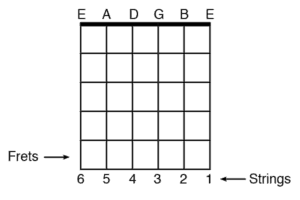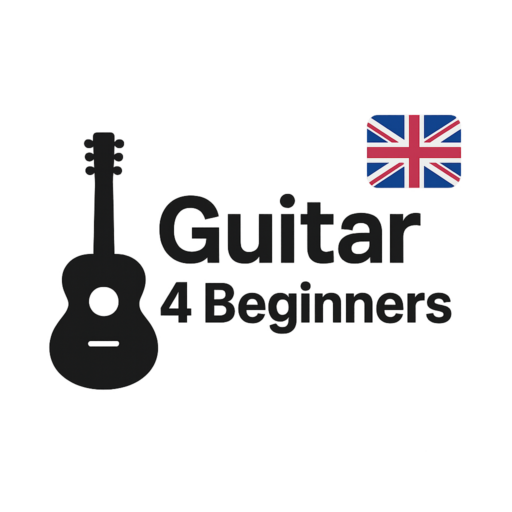Starting guitar can feel overwhelming, but don’t worry—we’ve narrowed it down to the five most important things you should learn first. Mastering these basics will set you up with the right habits and a strong foundation, whether you’re learning acoustic or electric.

The 5 First Things to Learn on Guitar:
1. Learn to Hold the Guitar Properly
Before you start playing, it’s important to learn how to hold your guitar. Proper positioning will make playing easier and more comfortable. If you’re sitting, place the guitar body on your dominant leg (right leg for most right-handed players) with the back resting against your stomach and chest. Sit up straight with relaxed shoulders. Your fretting hand (left hand for right-handed players) should have enough freedom to move up and down the neck.
For standing, use a guitar strap. Adjust the strap so the guitar sits at waist height or slightly higher. The goal is to maintain the same posture as when sitting. This will help avoid discomfort and allow your hands to move freely.
Holding your guitar properly will make learning chords and transitions much easier. It might feel awkward at first, but it’s a crucial step in your guitar journey.
👉 The video below also takes you through this step-by-step, so you can follow along and make sure you’re set up correctly from the start!
2. Learn To Tune the Guitar
A guitar that’s in tune is essential for sounding good. Without it, even the best players will sound off. Most guitars are tuned to standard tuning, E – A – D – G – B – E. It may seem tricky at first, but with practice, you’ll tune your guitar quickly.
The easiest way to tune is using a clip-on tuner or a tuning app on your phone. These tools help you tune each string to the correct note. Simply adjust the tuning pegs until the needle or indicator shows the correct pitch. Always tune up to the note, not down, as it helps keep your tuning stable.
Once you get the hang of it, tuning will become second nature. It’s one of the most important daily practices for any guitarist.
👉 Check out the video below for a step-by-step walkthrough on how to tune your guitar using a clip-on tuner or a free tuning app. You can follow along and have your guitar sounding great in no time!
3. Understand the basics of Strings and Frets
Knowing the layout of your guitar is crucial for making progress. Your guitar has six strings, each with a different pitch. The thickest string at the top is the low E string (6th) and the thinnest at the bottom is the high E string (1st). The strings are numbered from 6 (top) to 1 (bottom).
Frets are the metal strips along the neck. Pressing a string just behind a fret raises the note. The closer you get to the body, the higher the pitch. Visual markers on the 3rd, 5th, 7th, 9th, and 12th frets help guide your playing.
Understanding strings and frets is key to reading chord diagrams, tabs, and playing melodies. The more familiar you get, the easier it will be to navigate the fretboard.

👉 And don’t forget to watch the video below for a hands-on explanation that walks you through the basics, using a real guitar so you can follow along.
4. Learn To Play Some Easy Tunes
Now that you’re holding the guitar right, tuned up, and know your way around the strings and frets—it’s time for the fun part: playing your first real music. And you don’t need to learn full chords or complex fingerpicking to start impressing people. With just one string, you can play a bunch of recognisable riffs and melodies that sound awesome right away.
One-string tunes are perfect for beginners because they let you focus on rhythm, timing, and finger control without overwhelming you with too much at once. Songs like “Smoke on the Water” (Deep Purple), “Seven Nation Army” (The White Stripes), or even the first few notes of “Twinkle Twinkle” or the Star Wars theme can all be played on just one string. Seriously—it’s way more satisfying than you’d expect.
Besides being fun, these simple riffs build the exact kind of muscle memory you’ll need for more advanced playing later. Plus, there’s something incredibly motivating about being able to say, “Hey, I can play a song!”—even after just a short time on the guitar.
👉 Check out the video below to learn a few classic one-string riffs step-by-step. You’ll be playing something real before you know it—and trust us, it feels great!
5. Pick The Right Teacher or Online Course For you, and stick with it!
Once you’ve got the absolute basics down, the next big step is choosing how you want to continue learning. A good teacher or structured program can make your progress smoother, more fun, and way less frustrating. Whether you prefer learning in-person, through videos, or with interactive apps, there’s something out there for every learning style—and budget.
If you’re just starting out and looking for a structured, easygoing approach—Justin Guitar is one of the best options out there. It’s completely beginner-friendly, taught by an experienced and down-to-earth instructor, and the course is 100% free online. The Justin Guitar app is also fantastic if you’re learning on acoustic and want guided practice sessions, play-along songs, and instant feedback.
If you’re someone who enjoys a more game-like, interactive vibe—especially on electric—then the Gibson Guitar App might be a better fit. It feels more like playing a music video game than taking a lesson, which makes learning fun and addicting. You’ll get real-time feedback as you play, and the app adjusts to your pace.
Whichever route you choose, the key is consistency. Stick with a course that keeps you motivated and builds your skills in small, achievable steps. You’ll be amazed at how far you can go in just a few weeks with the right guidance.
👉 The video below is the starter module of Justin Guitar, who is highly recommended and actually takes you through a lot of what we go through above!
Final Thoughts
Learning guitar doesn’t have to be overwhelming—especially when you focus on the right things from the very beginning. By getting comfortable with how to hold your guitar, keeping it in tune, understanding the fretboard, playing simple one-string songs, and finding a learning method that works for you, you’re laying down the perfect foundation for long-term success.
The most important part? Just start. Even five minutes a day adds up faster than you think. You don’t need to be perfect—you just need to keep going. Celebrate the small wins (like your first riff or clean note), and don’t be afraid to revisit the basics as often as you need to.
There’s a whole world of music waiting for you, and now you’ve got the tools to start exploring it.


